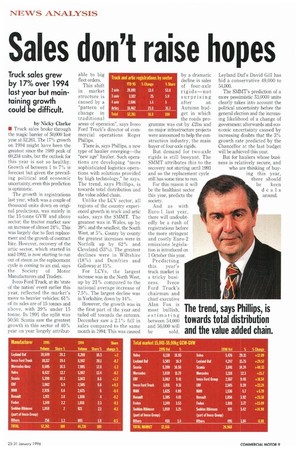Sales don't raise hopes
Page 11

If you've noticed an error in this article please click here to report it so we can fix it.
Truck sales grew by 17% over 1994 last year but maintaining growth could be difficult.
by Nicky Clarke • Truck sales broke through the magic barrier of 50,000 last year at 52,261. The 17% growth on 1994 might have been the greatest since the 1989 peak of 69,234 units, but the outlook for this year is not so healthy. Growth of between 1 to 7% is forecast but given the prevailing political and economic uncertainty, even this prediction is optimistic.
The growth in registrations last year, which was a couple of thousand units down on original predictions, was mainly in the 15-tonne GVW and above sector; the tractor market saw an increase of almost 24%. This was largely due to fleet replacement and the growth of contract hire. However, recovery of the artic sector, which started in mid-1992, is now starting to run out of steam as the replacement cycle is coming to an end, says the Society of Motor Manufacturers and Traders.
Iveco Ford Truck, at its 'state of the nation' event earlier this year, reflected the market's move to heavier vehicles: 61% of its sales are of 15 tonnes and above, with 39% under 15 tonne. In 1991 the split was 50:50. Scania saw the greatest growth in this sector of 40% year on year largely attribut
able to big fleet orders.
This shift in market structure is caused by a "pattern of change in traditional areas of operation", says Iveco Ford Truck's director of commercial operations Roger Phillips.
There is, says Phillips, a new type of haulier emerging-the "new age" haulier. Such operations are developing "more sophisticated logistics operations with solutions provided by high technology," he says. The trend, says Phillips, is towards total distribution and the value added chain.
Unlike the LCV sector, all regions of the country experienced growth in truck and artic sales, says the SMMT. The greatest was in Wales, up by 39% and the smallest, the South West, at 5%. County by county the greatest increases were in Norfolk up by 62% and Cleveland (53%). The greatest declines were in Wiltshire (18%) and Dumfries and Galloway at 15%.
For LCVs, the largest increase was in the North West, up by 21% compared to the national average increase of 7.5%. The largest decline was in Yorkshire, down by 14%.
However, the growth was in the first part of the year and tailed off towards the autumn. December saw a 2.1% fall in sales compared to the same month in 1994. This was caused
81095
2 axle 28,091 3 axle 3,102 4 axle 2,606 Artics 18,462 Intl
52,261
by a dramatic decline in sales of four-axle rigids-not surprising after an Autumn budget in which the roads programme was cut by £2bn and no major infrastructure projects were announced to help the construction industry, the main buyer of four-axle rigids.
But demand for two-axle rigids is still buoyant. The SMMT attributes this to the recovery not starting until 1993 and so the replacement cycle still has some time to run.
For this reason it will be the healthiest sector this year, predicts the society.
And as with Euro-1 last year, there will undoubtedly be a rush of registrations before the more stringent and costly Euro-2 emissions legislation is introduced on 1 October this year.
1.4 5 23.8 35.3
16.8 100
Predicting this year's truck market is a tricky busi ness. Iveco Ford Truck's chairman and chief executive Alan Fox is most bullish, estimating between 54,000 and 56,000 will be sold. Leyland Daf's David Gill has bid a conservative 49,000 to 54,000.
The SMMT's prediction of a more pessimistic 53,0000 units clearly takes into account the political uncertainty before the general election and the increasing likelihood of a change of government afterwards and economic uncertainty caused by increasing doubts that the 3% growth rate predicted by the Chancellor at the last budget will be achieved this year.
But for hauliers whose business is relatively secure, and who are thinking of buying this year, there should be keen deals around.
































































































